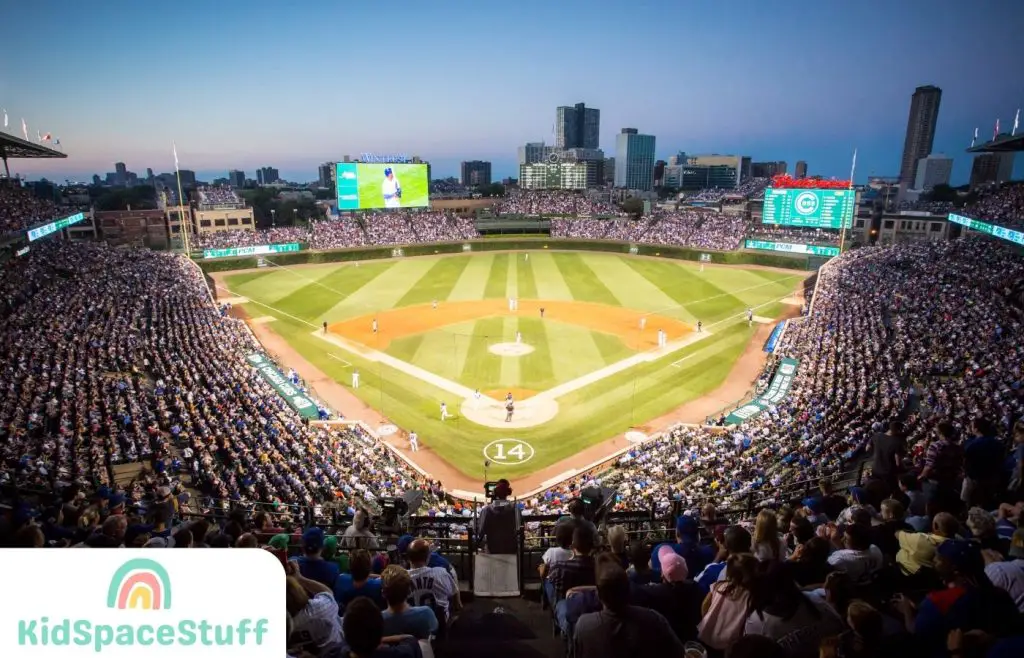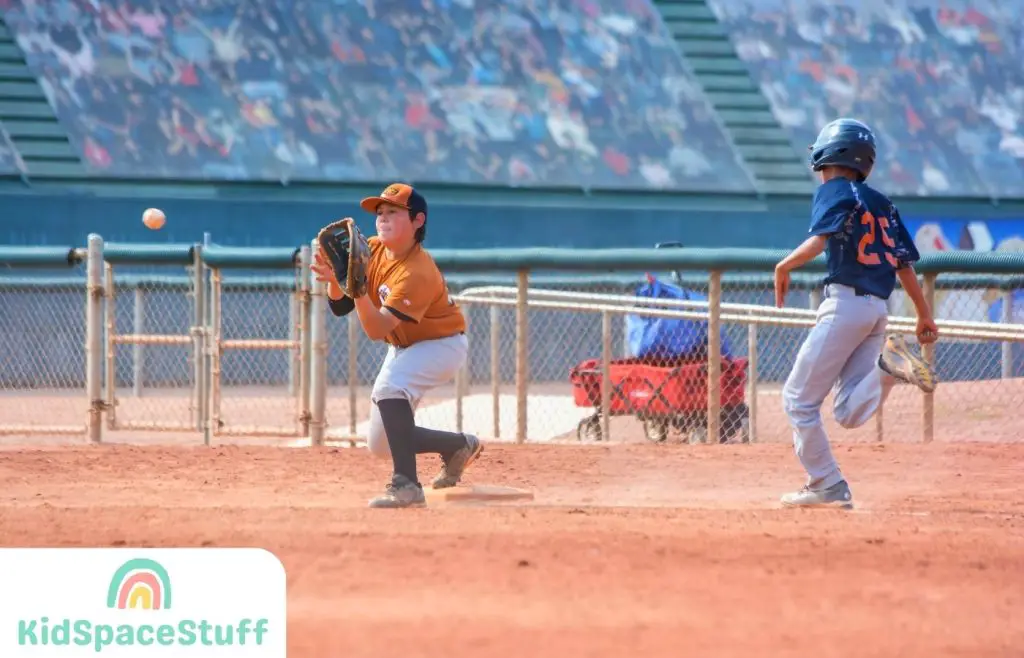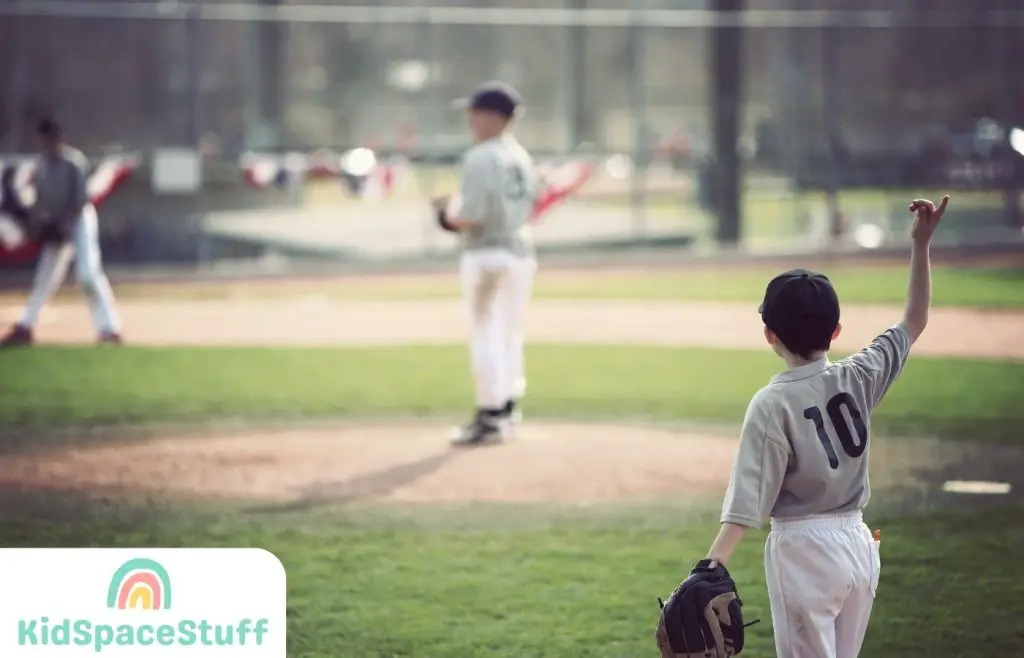If your child plays baseball like mine have, you might be wondering how long youth baseball games last.
While a baseball game might be fun for some, let’s be honest – not all of us enjoy them as much as others.
In this post, I’ll explore how long youth baseball games, little league baseball games, high school baseball games, and major league baseball games last so you can be prepared. Let’s dig in!
How Long Do Kids Baseball Games Last?

A kids baseball game will typically last around 1.5 to 2.5 hours, but this can vary depending on the league rules and other factors like the number of innings.
How Long Do Little League Baseball Games Last?
Little League baseball games typically last around 1.5 to 2 hours. These games have six innings and each team gets three outs per inning. Since these kids are learning the fundamentals, the main priority is fostering a fun and enjoyable environment for them to develop their skills.
How Long Do High School Baseball Games Last?
As for high school baseball games, they typically last around 2 to 2.5 hours. Like MLB and college, these games are played for nine innings, with each team getting three outs per inning. High school players are more experienced and faster in terms of pace, making the game length a bit longer than Little League.
How Long Do College Baseball Games Last?
College baseball games are closer to professional games in terms of length. They also play for nine innings and each team gets three outs per inning. On average, college baseball games last around 2.5 to 3 hours. The level of competition and strategy increases in college games, which can sometimes lead to longer playtimes.
How Long Do Professional Baseball Games Last?
If you’re a fan of professional baseball games (MLB), they usually last a little over three hours. These games also consist of nine innings with three outs per inning, just like high school and college games. It’s important to note that last season, the average nine-inning MLB game was three hours and 10 minutes long. The level of skill and intensity in professional games, along with various strategic decisions made by the teams, may contribute to the longer game duration.
Factors Affecting Game Length

Pitching Changes
In my experience, pitching changes can affect how long a kids baseball game lasts. When a pitcher is struggling or reaches their pitch count limit, the coach may decide to make a change, which takes some time.
Time Between Innings
The time between innings can also impact the game’s length. In kids baseball, teams usually have a set amount of time to switch between offense and defense, but if they take longer, the game will be extended.
Mound Visits
Sometimes, mound visits can add time to a game. If a coach wants to discuss strategy or calm down a struggling pitcher, they may decide to visit the mound, which can prolong the game.
Schedule
The schedule plays a role in game length too. Some leagues have strict time limits for games, while others allow for longer or shorter durations depending on the schedule. In such cases, games may be shortened or extended to fit into the allotted time.
Weather Conditions
Weather conditions can impact how long a game lasts. If it’s exceptionally hot or cold, players might need more breaks leading to longer games. Additionally, rain, wind, and other inclement weather can cause delays.
Skill Level
The skill level of the teams involved can affect game length. If both teams are evenly matched, they might have longer innings, while a mismatched game could end more quickly.
Umpires
Umpires also play a role in determining the length of a kids baseball game. The pace at which they make calls and control the game can influence its duration.
Postseason
Lastly, postseason games can differ from regular season games in length. With more on the line, teams may take extra time to strategize and make adjustments, potentially lengthening the game.
Regulation, Doubleheaders, and Extra Innings

When you consider the length of kids’ baseball games, there are several factors that come into play. In a regulation game, the standard is usually six innings for younger kids and seven innings for older kids. Each of those innings is divided into a top half and a bottom half, with each team batting in one half-inning before switching sides.
Now, let’s talk about doubleheaders. Sometimes, kiddos have to play two games in a row with just a short break in between. These situations often arise in tournaments or during makeup games when rescheduling is necessary. To make things easier on the young athletes, doubleheader games might be shorter than a typical game, but it ultimately depends on league rules.
Now, onto extra innings. This is when a game goes beyond the regulation number of innings because it’s tied. In kids’ baseball, extra inning rules are frequently modified to keep things moving along and to ensure that the game doesn’t drag on for too long. Some leagues implement a “speed-up” rule, where runners begin the extra innings on second base, or they may limit the number of extra innings allowed altogether.
Keep in mind that playoff games can sometimes have different rules. In these high-stakes situations, extra innings might be played as normal with no modifications. This is to keep things fair and make sure that the best team emerges victorious.
In short, kids’ baseball games can vary in length depending on various factors, including league rules, age groups, and whether the games are part of a doubleheader or playoff series.
Wondering how to prep for a baseball game as a parent? Check out the video below!
Influence of Timeouts, Delays, and Challenges
In my experience watching kids’ baseball games, I’ve seen how timeouts, delays, and challenges can impact the game duration.
When it comes to timeouts, they are pretty common, especially during kids’ games – just like with soccer games. Coaches use them to give players a break and discuss strategies. While the official rules might specify a limited number of timeouts per game, in youth games, there might be some flexibility. Of course, more timeouts can mean a longer game.
Now, let’s talk about delays. Delays happen for several reasons – weather, injuries, or maybe equipment issues. An unexpected downpour might halt the game for a few minutes or even an hour, depending on the severity. Field maintenance or replacing damaged gear can also contribute to some delays. It’s important to remember that, as these occurrences are unpredictable, they can extend the game time quite a bit.
Replay challenges, on the other hand, might not be as common in kids’ games as they are in professional ones. These challenges occur when the coach disputes a call made by the umpire. But, depending on the league and age group, video replay might not even be available. Nevertheless, if a challenge is allowed, it can add a few extra minutes to the game duration as the officials review the play.
Looking back at the games I’ve attended, these factors definitely have an impact on the length of a kids’ baseball game. While timeouts might be controllable and built into the flow of the game, delays and challenges can be a bit more unpredictable, making it difficult to determine just how long a game will last.
Frequently Asked Questions
What is the typical duration of a kids baseball game?
I’ve found that kids baseball games usually last between 1.5 to 2 hours. The duration depends on the age group and league rules. Often, younger age groups will play shorter games than older ones. Keep in mind, though, that the length can vary from game to game.
Are there any time limits in youth baseball games?
Yes, many youth baseball leagues implement time limits to keep the games moving and not drag on too long. For example, some leagues might enforce a 1.5 or 2-hour time limit. Once the time limit is reached, the teams will typically finish the current inning before ending the game.
How many innings do kids baseball games usually have?
Kids baseball games typically consist of fewer innings than adult games. For example, some leagues might have 6-inning games for younger age groups and 7-inning games for older ones. These shorter games help maintain the interest of young players and prevent the games from becoming too long.
What factors affect the length of a children’s baseball game?
Several factors can impact the length of a kids baseball game. Some of these factors include the number of runs scored, the pace of play, the skill level of the players, and the number of pitching changes. A game with higher-scoring, slower-paced play, and more frequent pitching changes will generally take longer to complete.
How do kids baseball games compare to MLB game times?
Kids baseball games are generally shorter than MLB games. As I mentioned earlier, kids games typically have fewer innings, and there are often time limits in place. Major League Baseball games last nine innings and take an average of a little over 3 hours to complete. In contrast, a kids baseball game usually lasts around 1.5 to 2 hours.
Final Thoughts
Here’s how long each baseball game will last:
- A Little League baseball game will last around 1.5 to 2 hours
- A high school baseball game will last around 2 to 2.5 hours
- A collegiate baseball game will last around 2 to 3 hours
- A major league baseball game will last around 3 to 3.5 hours
The length of a baseball game will depend on many different factors so it’s important to be prepared for a longer game than normal just in case. Most games will take under 4 hours to finish, but the longest games have exceeded 5 hours.
Need some gear for your child’s sports? Check out these articles!
KidSpaceStuff is a site dedicated to helping parents find the best interior design, activities, and inspiration for their kids.